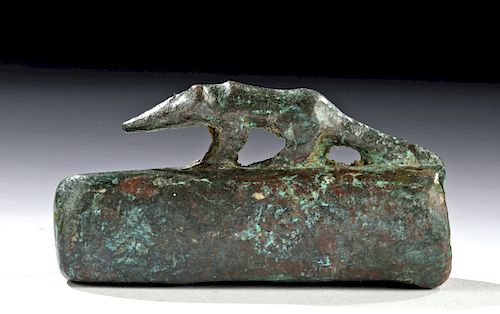Egyptian Leaded Bronze Sarcophagus w/ Shrew
Lot 13
About Seller
Artemis Fine Arts
686 S Taylor Ave, Ste 106
Louisville, CO 80027
United States
Selling antiquities, ancient and ethnographic art online since 1993, Artemis Gallery specializes in Classical Antiquities (Egyptian, Greek, Roman, Near Eastern), Asian, Pre-Columbian, African / Tribal / Oceanographic art. Our extensive inventory includes pottery, stone, metal, wood, glass and textil...Read more
Categories
Estimate:
$800 - $1,200
Absentee vs Live bid
Two ways to bid:
- Leave a max absentee bid and the platform will bid on your behalf up to your maximum bid during the live auction.
- Bid live during the auction and your bids will be submitted real-time to the auctioneer.
Bid Increments
| Price | Bid Increment |
|---|---|
| $0 | $25 |
| $300 | $50 |
| $1,000 | $100 |
| $2,000 | $250 |
| $5,000 | $500 |
| $10,000 | $1,000 |
| $20,000 | $2,500 |
| $50,000 | $5,000 |
| $100,000 | $10,000 |
| $200,000 | $20,000 |
About Auction
By Artemis Fine Arts
Jan 7, 2020
Set Reminder
2020-01-07 10:00:00
2020-01-07 10:00:00
America/New_York
Bidsquare
Bidsquare : VARIETY AUCTION - Antiquities / Ethnographic
https://www.bidsquare.com/auctions/artemis-gallery/variety-auction---antiquities-ethnographic-4787
Around the world & back in time - be amazed at the treasures you will find. Antiquities from Egypt, Greece, Italy and the Near East, Asian, Pre-Columbian, African / Tribal / Oceanic, Native American, Spanish Colonial, Russian Icons, Fine Art, much more! Artemis Fine Arts info@artemisgallery.com
Around the world & back in time - be amazed at the treasures you will find. Antiquities from Egypt, Greece, Italy and the Near East, Asian, Pre-Columbian, African / Tribal / Oceanic, Native American, Spanish Colonial, Russian Icons, Fine Art, much more! Artemis Fine Arts info@artemisgallery.com
- Lot Description
**Originally Listed At $400**
Egypt, Late Dynastic Period, 26th to 31st Dynasty, ca. 664 to 332 BCE. An intriguing cast leaded-bronze sarcophagus of a petite size surmounted with the petite effigy of a shrew. The sarcophagus is of a characteristic rectangular form, with a once-hollow interior that would have contained the remains of a mummified shrew that was carefully wrapped in linen. The upper side of the sarcophagus is modeled with a charming shrew figure as it would have appeared while still alive, with an elongated body, a sinuous tail, and a tapered snout. A fabulous example of a sarcophagus - covered in beautiful mottled green and brown patina! Size: 2.3" L x 0.75" W x 1.2" H (5.8 cm x 1.9 cm x 3 cm)
According to scholar Dorothea Arnold, "'The Voracious' was the ancient Egyptians' name for the shrew, an epithet that aptly describes the feeding habits of this tiny animal. In ancient Egyptian popular mythology the shrew was closely associated with the ichneumon. The shrew represented the blind aspect of a solar deity whose complement, endowed with keen eyesight, was understood to be the ichneumon." (Arnold, Dorothea. "An Egyptian Bestiary." The Metropolitan Museum of Art Bulletin, Spring 1995, Vol. LII, no. 4, p. 39)
Provenance: The Dere Family Collection, New York, USA, assembled 1970's-2000's; ex-Norman Blankman Collection, New York, USA, acquired in 1950's
All items legal to buy/sell under U.S. Statute covering cultural patrimony Code 2600, CHAPTER 14, and are guaranteed to be as described or your money back.
A Certificate of Authenticity will accompany all winning bids.
We ship worldwide and handle all shipping in-house for your convenience.
#138940Minor nicks and abrasions to sarcophagus body and shrew, with softening to finer details, and light encrustations, otherwise intact and very good. Light earthen deposits as well as great green and brown patina throughout. Possible repatination to areas of patina.Condition
- Shipping Info
-
All shipping is handled in-house for your convenience. Your invoice from Artemis Gallery will include shipping calculation instructions. If in doubt, please inquire BEFORE bidding for estimated shipping costs for individual items.
-
- Buyer's Premium



 EUR
EUR CAD
CAD AUD
AUD GBP
GBP MXN
MXN HKD
HKD CNY
CNY MYR
MYR SEK
SEK SGD
SGD CHF
CHF THB
THB















